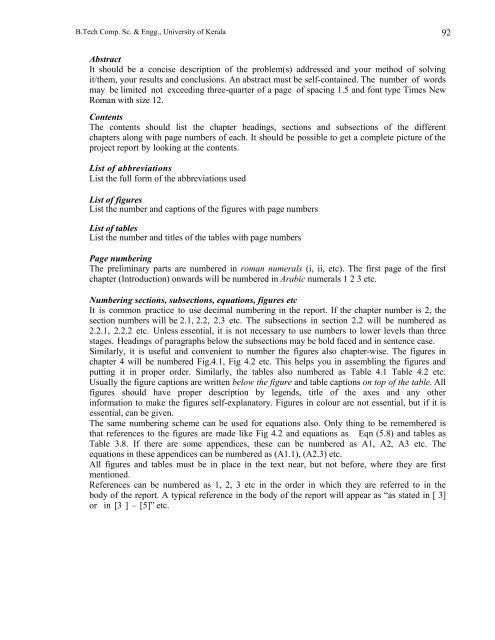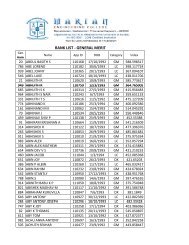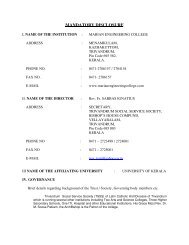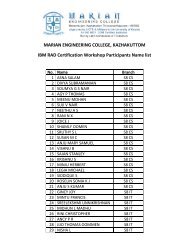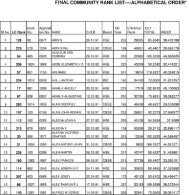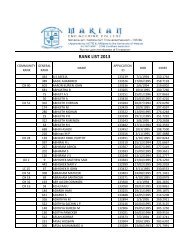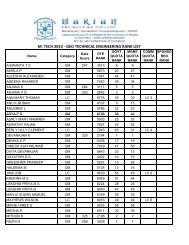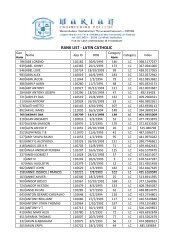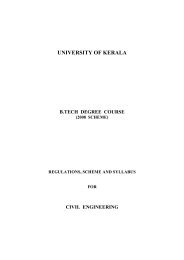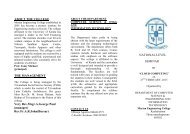UNIVERSITY OF KERALA - Marian Engineering College
UNIVERSITY OF KERALA - Marian Engineering College
UNIVERSITY OF KERALA - Marian Engineering College
You also want an ePaper? Increase the reach of your titles
YUMPU automatically turns print PDFs into web optimized ePapers that Google loves.
B.Tech Comp. Sc. & Engg., University of Kerala 92<br />
Abstract<br />
It should be a concise description of the problem(s) addressed and your method of solving<br />
it/them, your results and conclusions. An abstract must be self-contained. The number of words<br />
may be limited not exceeding three-quarter of a page of spacing 1.5 and font type Times New<br />
Roman with size 12.<br />
Contents<br />
The contents should list the chapter headings, sections and subsections of the different<br />
chapters along with page numbers of each. It should be possible to get a complete picture of the<br />
project report by looking at the contents.<br />
List of abbreviations<br />
List the full form of the abbreviations used<br />
List of figures<br />
List the number and captions of the figures with page numbers<br />
List of tables<br />
List the number and titles of the tables with page numbers<br />
Page numbering<br />
The preliminary parts are numbered in roman numerals (i, ii, etc). The first page of the first<br />
chapter (Introduction) onwards will be numbered in Arabic numerals 1 2 3 etc.<br />
Numbering sections, subsections, equations, figures etc<br />
It is common practice to use decimal numbering in the report. If the chapter number is 2, the<br />
section numbers will be 2.1, 2.2, 2.3 etc. The subsections in section 2.2 will be numbered as<br />
2.2.1, 2.2.2 etc. Unless essential, it is not necessary to use numbers to lower levels than three<br />
stages. Headings of paragraphs below the subsections may be bold faced and in sentence case.<br />
Similarly, it is useful and convenient to number the figures also chapter-wise. The figures in<br />
chapter 4 will be numbered Fig.4.1, Fig 4.2 etc. This helps you in assembling the figures and<br />
putting it in proper order. Similarly, the tables also numbered as Table 4.1 Table 4.2 etc.<br />
Usually the figure captions are written below the figure and table captions on top of the table. All<br />
figures should have proper description by legends, title of the axes and any other<br />
information to make the figures self-explanatory. Figures in colour are not essential, but if it is<br />
essential, can be given.<br />
The same numbering scheme can be used for equations also. Only thing to be remembered is<br />
that references to the figures are made like Fig 4.2 and equations as Eqn (5.8) and tables as<br />
Table 3.8. If there are some appendices, these can be numbered as A1, A2, A3 etc. The<br />
equations in these appendices can be numbered as (A1.1), (A2.3) etc.<br />
All figures and tables must be in place in the text near, but not before, where they are first<br />
mentioned.<br />
References can be numbered as 1, 2, 3 etc in the order in which they are referred to in the<br />
body of the report. A typical reference in the body of the report will appear as “as stated in [ 3]<br />
or in [3 ] – [5]” etc.


